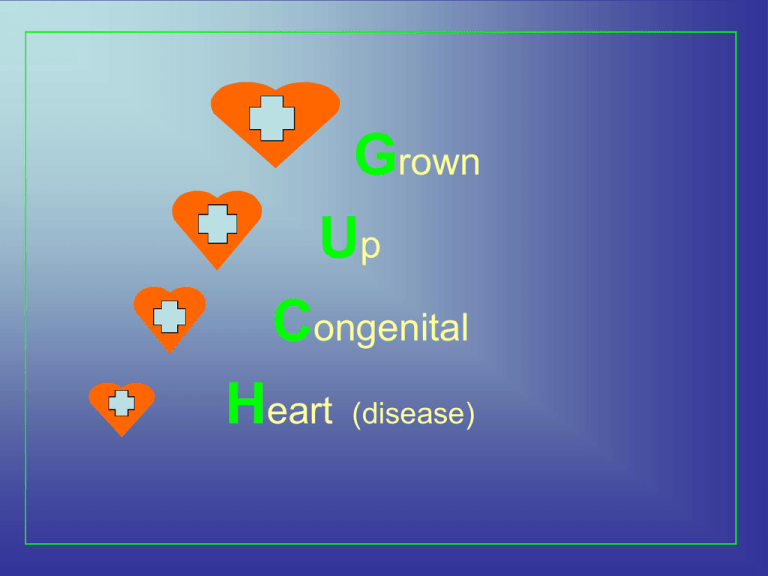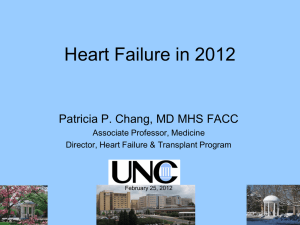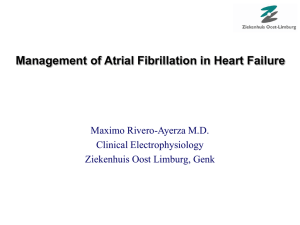GUCH - Aristea
advertisement

Grown Up Congenital Heart (disease) Ad. Pat Ped. Pat 30 70 1965 1500.000 ↑ 5% anno 1250.000 1000.000 750.000 500.000 250.000 1970 1980 1990 2000 2010 JACC 2001 Warnes JACC 2006 Williams Ad. Pat Ped. Pat 40 60 2005 RVEF 70% 60 50 40 30 20 10 0 8 10 12 14 16 18 20 22 24 26 ys Millane JACC 2000 Vander Velde Eur J Epidemiol 2005 ACE/ARB treatment Losartan … 7 pts Enalapril ….. 14 pts Lester AmJ C 2001 Beta/Blocker treatment … 8 pts Josephson Can J Card 2006 Hecther AmJC 2001 …..31 pts Doughan Am J Card 2007 Enalapril …. 9 pts Robinson Ped Card 2002 …. 14 pts Bouallal Card Young 2010 Losartan .. 37 pts Dore Circ 2005 Ramipril … 17 pts Therrien InT J Card 08 No high-quality data support the use It is difficult to conclude that B/blockade is beneficial Cardiac conditions at highest risk Type of procedure at risk 20 % 18 16 14 12 10 8 6 4 2 0 SVT VT Endocardits Engelfriet Eur H J 2005 CVA The principal reasons for 373 medical admissions to the Royal Brompton Hospital GUCH unit in 1997. Sommerville Heart 2002 40% 35 30 25 20 15 10 5 0 Arr Ac HF Inf Sync TE Chest pain Hem Ao An Card Arr Oth Kaemmerer Am JC 2008 The updated recommendations dramatically change long established practice for primary care physicians,cardiologists, dentists, and their patients. For ethical reasons, these practitioners need to discuss the potential benefit and harm of antibiotic prophylaxis with their patients before a final decision is made. Following informed review and discussion, some patients (and also physicians) may wish to continue with routine prophylaxis in the individual case, and these views should be respected. Br Med Bull. 2008;85:151-80. Adult congenital heart disease: a 2008 overview. Bédard E, Shore DF, Gatzoulis MA. Source Adult Congenital Heart Center and Center for Pulmonary Arterial Hypertension, Royal Brompton Hospital, Sydney Street, London SW3 6NP, UK Current ACC/AHA GL are much more restrictive concernig the use of prophylactic antibiotics. However , we advocate a prudent approach for endocarditis prohylaxis in patients with CHD Good oral hygiene and regular dental review have an essential role in reducing the risk of IE. It appears plausible that a large proportion of IE-causing bacteraemia may derive from daily routine activities such as tooth brushing, flossing…. In the majority of patients, no potential index procedure preceding the first clinical appearance of IE can be identified Transient bacteraemia occurs frequently in the context of these daily routine activities Atrial septal defect Interventional options: surgery or device closure Unresolved issues: surgery vs device closure 30 % 25 20 Mayo Toronto 15 10 5 0 < 20 21-30 31-40 41-50 51-60 61-70 > 70 ys JACC 2001 Warnes Y 40 > 50 y < 50 y 35 30 25 21 20 15 79 10 5 0 ASD VSD ToF CoAo TGA Marfan Fontan Cyan. Def Engelfriet Eur H J 2005 Ebstein’s anomaly RV to PA conduits VO2 ml/kg/m 50 45 40 35 30 25 20 15 10 5 0 Normali Normali NYHA I NYHA I NYHA II NYHA II NYHA III GUCH età media 33 y NYHA III Pazienti HF età media 59 y ….all should have a measurement of exercise physiology Diller Circulation 2005 Non cardiac Peri op CV Analyzing the mortality causes in GUCH pts it appears that cardiovascular death is the most frequent: 65% of all deaths, excluding the perioperative cardiac surgery deaths. 17% 18% 65% Non cardiac Peri op Other CV 17% 26% HF SD The most common mode is SD, followed by progressive HF 18% 21% 18% Am J Cardiol 2000 Oechslin Specific criteria for ICD implantation for primary prevention have not been well defined yet ICD therapy in adult patients with ToF Witte Europace 2008 ICD in Tetralogy of Fallot Khairy Circ 2008 SD and ICD in TGA With Intra-atrial Baffles: A Multicenter Study Khairy Circ Arr 2008 ...inappropriate anti-tachycardia pacing delivery (20%) and inappropriate cardioversion (25 %) ... Conclusion :Tetralogy of Fallot patients have a higher risk of inappropriate therapies ….. 36 patients (29.8%) experienced complications, of which 6 (5.0%) were acute, 25 (20.7%) were late lead-related, and 7 (5.8%) were late generatorrelated complications. Conclusions:…late leadrelated complications are common. 14 patients (37.8%) experienced complications: 5 (13.5%) acute, 1 (2.7%) late generator related, and 12 (32.4%) late lead related. Cardiologo pediatra GUCH Cardiologo dell’adulto IGG RETE INTERAZIENDALE per la GESTIONE dei GUCH Ambulatorio per i GUCH ASL 3 - Nervi ICLAS Cardiologo Pediatra GUCH Cardiologo dell’Adulto ASl 3 IGG RETE INTERAZIENDALE per la GESTIONE dei GUCH Ambulatorio per i GUCH ASL 3 - Nervi ASl 3 ICLAS Cardiologo Pediatra GUCH Cardiologo dell’Adulto







